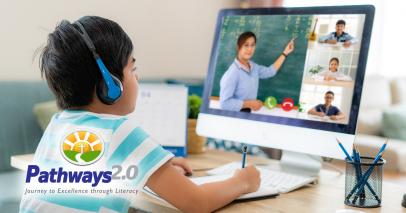 By: Kendall Hunt RPD with contributions from the editorial team of Pathways2.0
By: Kendall Hunt RPD with contributions from the editorial team of Pathways2.0
Stephanie Heath Nash is a classroom teacher with more than 20 years of experience teaching everything from kindergarten through eighth grade, with the majority of her time spent in grades K–2. In addition to her classroom experience, Stephanie also played a key role in the writing and development of the Kendall Hunt Religious Publishing Division’s revised Pathways2.0 curriculum for grades 1 and 2.
We recently caught up with Stephanie via email to learn about how life in her hybrid kindergarten classroom has been going this year. Here, she shares her story and offers insights for fellow teachers as the educational field continues to adapt to the ongoing pandemic.
Balancing technology and staying safe
Stephanie teaches in a hybrid classroom, with students attending class in person as well as remotely, so technology is key to her daily routine.
“I have a huge TV, a ceiling-mounted camera, two computers, a projector, and a document camera to contend with every day,” she said. She uses Google Meet and Google Slides to present her daily lessons so that both in-person and virtual students can keep up. Usually things run fairly smoothly, she said, although “the technical issues can really be a thing some days.”
For students learning from home, Stephanie also puts in the extra prep work to send home all textbook pages/necessary supplies and a schedule/work calendar every two weeks. Because her virtual population fluctuates due to students being in and out of quarantine, she’s constantly working to make sure all students have the resources they need.
Pandemic safety procedures have altered Stephanie’s classroom setup, of course. Her students’ tables have been replaced by individual desks, with Velcro markings on the floor to help students remember to stay 6 feet apart. Centers and group activities have been eliminated, with hands-on materials and supplies kept in plastic tubs at students’ desks. Masks and frequent handwashing are the new normal.
“Students do not intermingle with other students at any time,” she said.
Working hard to reach each child
If you’re a teacher worrying that you’re not providing an equitable educational experience to both in-person and remote students, you’re not alone. Stephanie told us this challenge has been one of the biggest hurdles of the hybrid classroom for her.
“You never feel like you’re doing an awesome job—you feel like someone’s getting shortchanged, either the online kids or the in-person kids, depending on the day and how the situations play out,” she said.
Stephanie shared that one way she stays connected with her virtual students is by meeting with them individually in person for weekly assessments on Friday afternoons, “so that I can see them in real life and connect.” She also holds private virtual meetings with online students for phonics and math to ensure they all have a solid basis in these skills.
“It is critical that all my students have the same educational experience and that they are familiar with our classroom routines and expectations,” she said.
A new kind of classroom management
As Stephanie’s students have adapted to their unique learning situation, she’s had to find new ways of keeping them focused.
“I’ve never seen a whole group of students who need such a copious amount of movement and verbal interaction before,” she said. “I don’t have behavior issues; I have 16 boisterous students who are learning a lot, but they’re very noisy and active while doing it.”
It’s a challenge that many hybrid teachers have encountered this year—how to keep students’ attention through the computer screen—and everyone has found unique ways of doing so. For her part, Stephanie has found that she needs to “perform extra” to keep the online students from “zoning out.”
She has also discovered that a strict schedule is vital to keeping virtual and in-person learners at the same pace.
“You absolutely must stay on schedule; there can be NO teachable moments that take over the next class period,” she said. “You can’t just decide to scrap a lesson and do something else.”
The signs of success
Although the pandemic has forced Stephanie to stretch her creative muscles in ways she never could have imagined, and she said that “it can feel like madness” sometimes, she also has proof that her efforts are paying off. Her students are highly engaged, she said (even the parents agree), and despite the occasional chaos, they are usually on task and on topic.
In fact, her recent assessments yielded a surprising result: most of her students are well above where she needs them to be by the end of the first semester.
“Giving our end-of-semester assessments in December was really rewarding for me because I could take time to see just how much they’d grown and how ahead of expectations so many of my students are,” she said. “So, while I might not feel that individual days are necessarily successful, the overall growth since August has proven me wrong.”
The lesson is clear: thanks to teachers like Stephanie who are willing to put in the work, students are still learning and thriving during these extraordinary circumstances. As we enter the spring semester and a new year, the Kendall Hunt Religious Publishing Department salutes all teachers working hard to keep students on track. Thank you for all you do!